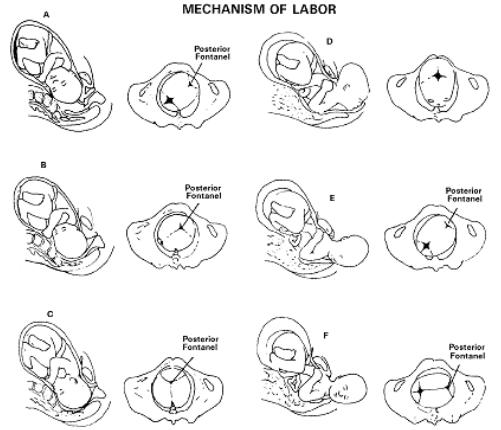This is the Archived Desktop Edition.
You should be transferred to the Newest Edition for Desktop and Mobile within 2 seconds.
|
Lesson 10: Fetal Positions and Adaptations
10-3. FETAL ADAPTATIONS (OR THE MECHANISM OF LABOR)
a.
Cardinal Movements. This refers to the movements made by the fetus during the first and second stage of labor. As the force of the uterine contractions stimulates effacement and dilatation of the cervix, the fetus moves toward the cervix. When the presenting part reaches the pelvic bones, it must make adjustments to pass through the pelvis and down the birth canal (see figure 10-6).

|
A--Descent. B--Flexion. C--Internal rotation to OA. |
D--Extension. E--Restitution. F--External rotation. |
Figure 10-6. The mechanism of labor in the left occiput anterior (LOA) presentation.
b.
Fetus in the Vertex Position. The fetus in the vertex position makes seven adaptations or cardinal movements. Refer to figure 10-6.LOA or LOT, rotation is only a short distance-45 to 90 degrees.(1) Descent. The fetus head is pushed deep into the pelvis in a sideways position, the face is to the left and the occiput is to the right.
(a) In a primigravida, this may occur two weeks before delivery. This is referred to as "lightening." Lay people might call this "dropping."
(b) In a multipara, this may not occur until dilatation of the cervix.
(2) Flexion. As the fetus head descends, the chin is flexed to come into contact with the infant's sternum. The occiput position allows the occipital bone in the back of the head to lead the way (smallest diameter of the head).
(3) Engagement. This is when the presenting part is at the level of the ischial spines or at a zero (0) station. Before this time, it is referred as "floating."
(4) Internal rotation.
(a) The amount of internal rotation depends on the position of the fetus and the way the head rotates to accommodate itself to the changing diameters of the pelvis.
(b) If the fetus starts to descend in
(c) If the head is in a posterior position, it may mean a turn of 180 degrees.
(d) Occasionally, the fetus may not turn to the anterior position and is born O.P. (occiput posterior).
(5) Extension. As the previously flexed head slips out from under the pubic bone, the fetus is forced to extend his head so that the head is born pushing upward out of the vaginal canal. The natural curve of the lower pelvis and the baby's head being pushed outward forces distention of the perineum and vagina. As it moves through the vaginal canal, the chin lifts up (extends) and the head is delivered. During this maneuver, the fetal spine is no longer flexed, but extends to accommodate the body to the contour of the birth canal.
(6) External rotation restitution.
(a) Once the fetus head is out, it will turn to line up with its back, revealing its position just before internal rotation of the head. This is called restitution.
(b) This aids in internal rotation of the shoulders to an anteroposterior diameter of the pelvic outlet or shoulder rotation.
(7) Expulsion.
(a) The top of the anterior shoulder is seen next just under the pubis.
(b) Gentle downward pressure by the physician delivers the anterior shoulder.
(c) The head is gently raised to deliver the posterior shoulder.
(d) The rest of the body follows the head, which then completes expulsion.
(e) The fetus remains completely passive as it moves through the birth canal.
c.
Movement. The first four movements (descent, flexion, engagement, and internal rotation) do not have to occur in any specific order.A general understanding of how the fetus may present itself during labor will help you to understand why some labors are so long and difficult. In addition, this will help you in understanding what the fetus must go through during the process of presenting himself out of the patient's womb.
|
The Brookside Associates Medical Education Division is dedicated to the development and dissemination of medical information that may be useful to medical professionals and those in training to become medical professionals. This website is privately-held and not connected to any governmental agency. The views expressed here are those of the authors, and unless otherwise noted, do not necessarily reflect the views of the Brookside Associates, Ltd., any governmental or private organizations. All writings, discussions, and publications on this website are unclassified.
© 2007 Medical Education Division, Brookside Associates, Ltd. All rights reserved